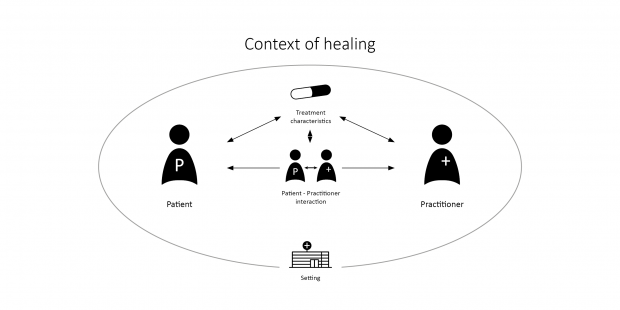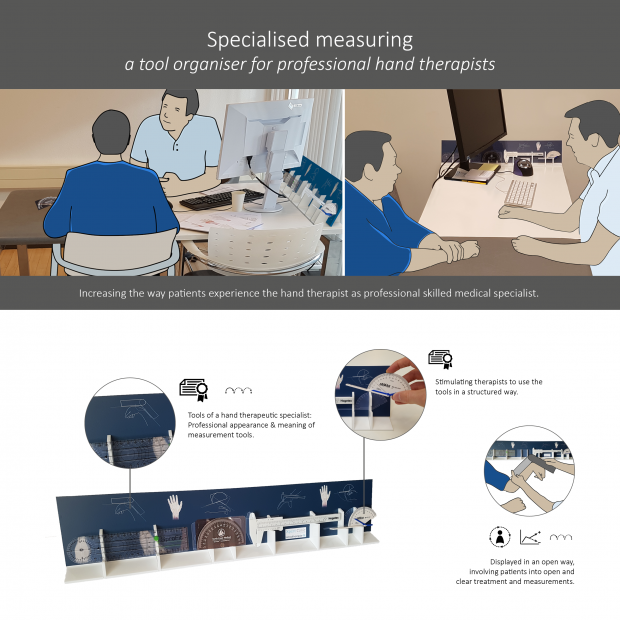Introduction
Do you remember a moment in which an element or event during a medical treatment gave you increased confidence that you would get better soon? Maybe it was the empathy of the doctor, carefully listening to your story, maybe it was the positive recommendations of relatives that increased your trust in a treatment, or maybe it was the scan that was made on your request, despite making it was medically not necessary. When asked, many people can recall such moments that boosted their confidence in a positive outcome.

Figure 1: The colour, shape and brand of pills trigger placebo mechanisms. Which of these do you believe work best against headache?
Research in medicine and psychology has demonstrated that placebo treatments can lead to clinically meaningful effects which are created by the context of the treatment. Therapeutic rituals are acknowledged as the core of contextual healing effects. Incorporating these rituals into regular medical treatments can lead to increased positive treatment outcome. To design for contextual healing in clinical practice, more insight is needed in the key ingredients of a ‘successful’ therapeutic ritual and in their working towards healing.

Figure 2: The context of healing.
Research was executed in a hand therapeutic context. Because data from patient’s questionnaires by the Xpert Clinic indicates that expectancies of conservative treatments (physiotherapy only, non-surgical) are lower than that of surgical treatments (surgery followed by physiotherapy), the question arose how to increase this treatment outcome expectancies by integrating contextual healing mechanisms in a patient’s journey for hand and wrist physiotherapeutic treatment?
Research activities & outcomes
Through a literature study, placebo mechanisms were identified. These mechanisms lead to directly increased expectancies to heal, but they also affect each other. Impact and mechanisms of the placebo effect are context-, illness- and patient-dependent. However, patient-practitioner interaction is considered as the most important factor in contextual healing.

Figure 3: The role of contextual healing (‘placebo’) in a treatment.

Figure 4: Placebo mechanisms.
To understand the presence of placebo mechanism in hand therapeutic context, observations were made during different phases of the patient journey, the presence of mechanisms was discussed with medical professionals, and patients were interviewed about their belief in treatment outcomes. Several mechanisms were already used by doctors and therapists, although not always in a conscious way. For example, patients are involved in diagnosis and treatment decisions. However, it was seen that patient’s belief in a treatment was influenced by the overall appearance of the therapist they were facing. Finally, an important patients’ motivator to belief in their treatment is the experience of improvement in daily life activities.

Figure 5: Patient’s outcome expectancies discussed with the use of a treatment journey.
Design directions
Using the insights on the presence of placebo mechanisms in the context of hand therapeutic treatments, several design concepts were made to foster placebo mechanisms. Among them were concepts that made results more experienceable, a concept that focussed on managing patient’s expectations, a concept that stressed the hand-touching moment within a therapy session as an important moment of the therapeutic ritual and a concept that created better understanding to patients about their disease and reasoning for their exercises. The concept that was chosen to continue with was increasing the professional appearance and behaviour of therapists, in order to increase patients’ belief in positive treatment outcomes.

Figure 6.1: Design direction – Concept stressing the hand-touching moment as an important moment of the therapeutic ritual by the use of focussed light.

Figure 6.2: Design direction – Creating understanding of the diagnosis by projection of the anatomy on the patient’s hand.

Figure 6.3: Design direction – The hand physiotherapist as craftsman: increasing the professional appearance and behaviour of therapists.
Final design
A final design was made that fosters placebo mechanisms by increasing the way patients experience the therapist as a skilled medical professional. Specialised measuring: the tool organiser for hand therapists, presenting the measurement tools in an open, professional way to the patient. The design motivates the therapist to measure with a professional and structured attitude. The presentation of the tools lifts them towards the level of medical equipment. Being involved in a session with a skilled professional, the placebo effect on patients is increased.

Figure 7: Final design.
Prototype
By use of a prototype, the organiser was tested in actual therapeutic practice. Results show more structured therapists’ behaviour and show patients’ fascination for and attraction towards the design, indicating that the professional appearance and behaviour of the hand therapist and the session room is increased. Although direct involvement of patients could be improved, and a more suitable place for the design in the room has to be found, the design is assessed as useful by therapists. When patients experience the therapist through the use of the design as a more skilled professional, the design might contribute to contextual healing.

Figure 8: Evaluation in clinical context.



